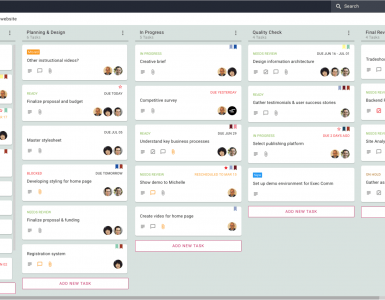Going freelance requires courage, that’s for sure. In the end, it means abandoning the comfort of permanent employment, steady paychecks, and a well-known working environment. But if you’re considering taking the leap to become a freelance social media manager, you need to know that there are also plenty of benefits. Going freelance can actually be a life-changing step in your career; here’s why:
- As a freelance specialist you have no fixed working hours; as a result, you can plan your days as you like
- You can continuously stack up new skills as you’re working with a wide range of clients
- You’re able to choose the people and projects that you want to work on
- Most importantly, as a freelance social media specialist, you can negotiate higher rates than in-house managers.
So, where do you start? There are several steps that you should take, and they’re all listed below.
Who Can Become A Freelance Social Media Manager?
1. Marketing Graduates
It definitely takes more than courage to become a freelance social media manager.
You might be asking yourself whether you need a degree in marketing or a related field. Well, a degree would definitely be an excellent addition, but it’s not compulsory.
Social media marketing is developing so fast that a degree from two years ago may already be… well… outdated.
But it doesn’t mean that you shouldn’t study social media.
Following industry blogs and social media updates would be a better, up-to-the-minute source of information. You can also attend courses and conferences, listen to podcasts and join industry communities (like Facebook groups) to keep up with the industry news.
2. Experienced Specialists Vs. Inexperienced Enthusiasts
One thing that can definitely help you start freelancing is experience.
It’s great if you’ve worked as a social media specialist, but that’s not the only way to gain experience.
If you’re studying, try to involve yourself in academic projects and internships related to social media.
Also, everyone can volunteer or develop their personal social media profiles; it all counts as experience. If you’re passionate and hard-working, nothing can stop you from gaining experience.
Regardless of how you gain experience, here’s a list of skills one should have to become a successful social media manager:
- Good writing and research skills
- An understanding of how to build engagement and grow your social media following
- An ability to analyze social media statistics, and strategic thinking skills
- A good sense of aesthetics and trends
- An ability to run Facebook, Instagram, LinkedIn and Twitter ads
- Empathy and interpersonal skills
- Creativity
So, How Do You Become A Freelance Social Media Manager?
1. Register As Self Employed
It’s nothing scary. In most countries, all that it entails is filling out a couple of forms. After that, in about 30 minutes, you can call yourself an entrepreneur. Simple, right?
In most countries, you can also be employed and self-employed at the same time. That’s an option for those of you who’d like to freelance after hours and not quit their job (yet).
Here’s how you can register as self-employed in the United Kingdom.
2. Resolve Any Existing Financial Issues
As you plan to work for yourself, you need to decide whether you’ll be using your personal bank account or if you’ll set up a separate account for your earnings.
The first option may sound tempting, but it’s actually smart to set up a separate bank account. Here’s why:
- You won’t get confused while doing your taxes
- You won’t get lost wading through the endless transaction history
Another thing you should consider is insurance. In some countries, a certain degree of protection can be granted to the self-employed by the state (e.g. health insurance), but it depends on the individual country’s law. Here are the types of insurance you should get yourself in the UK.
3. Set Your Prices
Now over to the tougher part: setting your prices.
It’s best to start by calculating your monthly expenses, as that will be your baseline. Remember that as a self-employed person you also need to cover taxes and other business-related expenses.
But there’s more to life than just paying the rent, right?
I’d say you should add around 20%-30% to your monthly expenses and divide it by the number of hours that you can devote to your work. Now, you’ve got your hourly rate.
Still, the number that you obtained may be inadequate. Check out other influencers’ prices by searching their websites. Look up influencers who operate in the same country as you do. The rates differ between countries as they go in line with the respective living costs and working standards of each individual country.
Here’s more about calculating your freelance rate.
4. Create A Portfolio
If you’re a creative soul (and I’m sure you are, all social media enthusiasts are!) you’ll love this part.
But first things first, let’s have our definition in order:
A portfolio is a collection of work samples that you can show to your would-be clients to demonstrate your experience and expertise.
In this industry, it’s neither a CV, nor a resume. Working in a creative environment requires creative means: a visual representation of your skills.
So, how do you create a social media portfolio?
You can start with a short introduction of yourself. Remember to mention your skills, experience and courses that you did in social media.
Next, try to select the most representative content examples (posts, stories, Tweets) that you created and showcase them in a neat way. That’s also where you can showcase your unique style.
The visual part should fit the industry standards, but if you can make it look a million dollars, that’s definitely a competitive advantage.
A section with analytics for your content would be a nice addition. It will prove not only your aesthetic sense and creative abilities but also strategic thought.
You can create your portfolio in many forms: a PDF, Slides, a Pinterest board. But I’d go for a webpage.
A webpage is easily adjustable and shareable. Most importantly, your potential clients may reach for your portfolio even without talking to you in the first place.
If you already have a website, add the portfolio as a separate webpage. You can collaborate with a professional to bring your creative vision to life.
5. Choose A Niche
There’s no one social media pattern that fits all industries. Your content should differ depending on whether you post for a beauty brand or a SaaS company.
It’s not that you can’t manage profiles for both brands, but knowledge, audiences, and trends differ for every industry, and it takes time to specialize in a specific area. That’s why it’s best to choose a niche.
Your niche should be narrow, but not too narrow. If you go for home decor, that’s “narrow enough”. Don’t limit yourself to flower pots or soy candles.
Specialization has one more advantage: Money.
If you direct your time and energy fully to one specific area, you might earn yourself a reputation as one of the best in the industry. This will allow you to increase your rates according to demand.
6. Market Your Services
That’s the moment when you shout out to the world.
Now, you’re the object of promotion. Market your services (and yourself as an expert!) just as you market others’ on social media.
Take care of your personal presence on social media. Post regularly about your services to stay on the radar of your prospects.
You may consider paid advertising or make use of your social media superpowers and create posts that have a high probability of going viral.
Using social media to promote your social media services is probably the most relevant idea, but you can also try guest blogging or sharing your expertise for articles, blog posts, podcasts, or even TV shows!
To do so, you can sign up for daily notifications from HARO, a portal that links bloggers and journalists with experts, and check if there are any subjects related to your area of specialization that you could contribute to.
7. Equip Yourself With The Right Tools
As a social media professional, you can use a social media management tool. You’ve probably heard about AgoraPulse or HootSuite, but affording one of them may be a bit of a challenge for a newbie freelancer.
Having said that, there are alternatives out there that are worthy of your attention, such as NapoleonCat. It’s a social media kit that will help you in managing engagement from all major social media platforms, publishing and scheduling content, automated reporting, and analytics.
One bonus feature is that the tool allows you to automatically (yes, automatically!) handle generic and repetitive comments and messages or delete spam.
You should also think about tools that will help you with content creation. With Canva, you can create your static posts and social media stories.
The basic (but extensive) version is free, but if you’d like to have access to more elements from top graphic designers, the Pro version starts at $9.95 a month.
For infographics, consider Venngage, and for videos, you may find Animoto helpful.
8. Find Your First Freelance Job
You can find prospects in different, sometimes very surprising places.
To get started, try to register on one of the freelance marketplaces (like Twine) that will help you connect with companies and brands.
Twine allows you to build a portfolio and network with other freelancers but most importantly, it helps you to engage with clients, pitch your services, and get hired.
You can also search for jobs on social media, for example, in Facebook Groups.
People don’t use Facebook solely to post pictures of their pets anymore. They actually engage in professional groups like this one.
Identify two or three groups that are the most relevant to your career. Type in a phrase (e.g. “social media jobs”) into Facebook’s search bar to start your research.
Wrapping Up
And there you have it! Becoming a freelance social media manager isn’t as scary as it seems, right?
If there’s anything that is keeping you from freelancing tell us in the comments. We’re here to help you overcome your boundaries!
Ready to get hired? At Twine, we have dozens of top-quality jobs being posted each and every day. From design to marketing, development to copywriting – there’s a job ready for your skills. Join the marketplace of diverse creative talent here.











